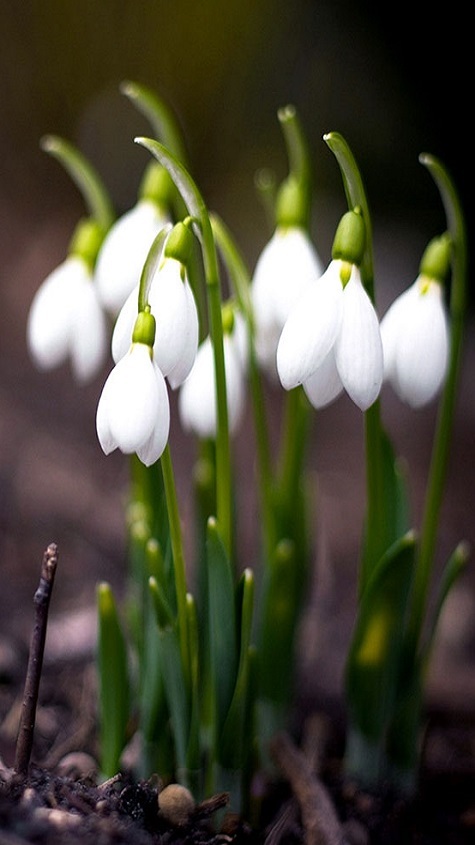February is a fickle month. It gives with one hand and snatches back with another. We wait patiently for it to arrive throughout the inconspicuous days of January, hoping that when it does, it will bring with it discernible signs of spring. And yet, more often than not, we find ourselves held hostage in the relentless grip of winter. But if we take the time to look, we will see that February is actually a plucky little month; one full of courage and determination. For underneath the silver-thatched grass and iron-clad earth, the cycle of the seasons is well underway.
Most of us prefer to observe February’s passing from the comfort of our homes. It’s the month we simply have to get through. A mere box that needs to be ticked. But as the naturalist author Edward Step once wrote, ‘We cannot learn the story of the year if we only read eight or nine of its twelve chapters’.
If you are undaunted by the biting breezes and steely skies, and feel adventurous enough to step outside, you will find that our briefest month is actually one filled with optimism and charm. For
February may be the shortest month of the year, but what it lacks in number of days, it more than makes up for in accomplishments. Daylight hours start to increase rapidly, and by the end of the month, we have 3 additional minutes of daylight to enjoy. This may seem inconsequential as a figure, but those precious minutes are the rungs of the ladder upon which spring climbs out from the clutches of winter.

It is often said that winter can feel longer in towns and cities and that the arrival of early spring is more noticeable in the countryside. Perhaps this is because unlike autumn, which always seems to arrive boldly and ablaze with colour, spring steps forward tentatively, with an unassuming shyness. That is often how it feels at Scone Palace. The once lush, burgeoning trees that beckoned you through the pathways remain stubbornly haggard and bony. The earth feels bland and unyielding underfoot. And yet, if you look more closely, you will see that the earth is rich and deep, built from the layers of seasons past. You may see paw prints in the frost or snow, signalling that animals are once again on the move. You may hear the buzzing of early pollinators searching for pollen and nectar. The increasing daylight will have awakened nature’s conductor as he taps on his music stand, ready to begin the overture of the dawn chorus. Then of course, there are the snowdrops.
For those of you who have always believed the snowdrop to be native to Britain may be surprised to learn that it was first recorded on mainland Europe and introduced to Britain at the start of the 16th century. At this time, the plant was classified as a member of the leucojum family as listed in English herbalist’s John Gerard’s General Histoire of Plantes published in 1597. It wasn’t until 1753 that Swedish botanist Carl Linnaeus renamed the plant using the Greek terminology we still use today: Galanthus from the Ancient Greek gála (milk) and ánthos (flower). However, the full Latin name for our adopted common snowdrop is galanthus nivalis; nivalis being the Latin word for snow.
In 1770, only 17 years after its nomenclatural christening, the snowdrop was first recorded in Britain, having naturalised in Worcestershire and Gloucestershire. The snowdrop was quick to spread, both physically and symbolically. The Victorians, who were known for their fascination with floral symbolism and the language of flowers, associated the flower with hope. However, to the superstitious Victorians, the snowdrop also became the harbinger of death, as swathes were planted and thrived in graveyards. It was believed that if you bought them into your house, the Grim Reaper wouldn’t be far behind. However, no such qualms worry us today. A few snowdrop stems on the mantelpiece bring comfort and joy as we patiently watch each week of winter pass by, stamping the snow from its boots at our thresholds and lifting the latch on the garden gate into spring. But if you are fortunate enough to live near an established snowdrop garden or woodland, then nothing equals the wonderment of actually walking among them.
Every year, Scone Palace welcomes visitors to its annual Snowdrop Festival (Friday, Saturday and Sunday only). Originally designed to welcome the family home from their winter travels, the snowdrops have naturalised over many generations and now cover the grass verges, as though a delicate lace wedding veil has been laid down upon them. In a matter of days, the woodland at Scone Palace becomes stippled with little dots of white, as the grounds turn into a pointillist masterpiece. Visiting on a crisp day is like stepping into a paperweight and looking out from underneath a glass-like sky. The dappled light falls through the trees illuminating clumps of pristine flowers heads; it is their cue to enter stage left, like a troupe of ballerinas in tutus, waiting to leap and dance in the first breath of spring.
Although the majority of bulbs are our native galanthus nivalis, there are few others to look out for as you meander through the guided Snowdrop Trial. Look closely and you may see the double white flowers of galanthus nivalis ‘Flore Plano’ nodding in a whispered conversation with the pleated snowdrop, galanthus plicatus. As you glance back through the ancient stone archway, you may catch a glimpse of the next generation of snowdrops, those that have cross pollinated to create a tall, robust flower that stands proudly above the crowd. But whether you have come to escape, reconnect or simply observe, a walk among the snowdrops at Scone Palace will leave you feeling as though you have pressed your reset button. Because that is what February is, it is a month of readjustment and acclimation, giving us a second chance to get it right. A time to reflect on the blunders of January and make plans for the year ahead. Because as the British poet Patience Strong once wrote, ‘In February, there is everything to hope for and nothing to regret’.
Other News

Top Five Things To Do At Scone Palace Garden Fair
24th May 2023

The Crowning Place of Scottish Kings
04th May 2023

The Palace Awaits
29th March 2023

Georgina Ballantine’s Giant Catch
14th October 2022

Man's Best Friend
01st September 2022

British Cut Flowers Week & The Garden Fair
05th July 2022

Scotland, Scone and Fashion
01st June 2022

The Celebration of Easter
19th April 2022

Ancient Scottish Sport of Curling
30th March 2022

Ever wondered what it is like to work in a Palace?
04th February 2022

